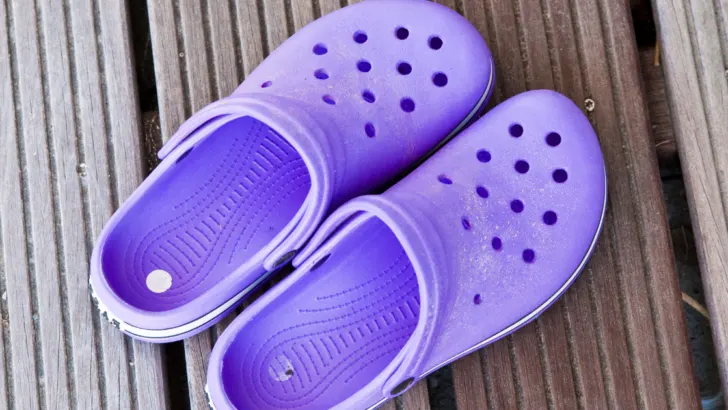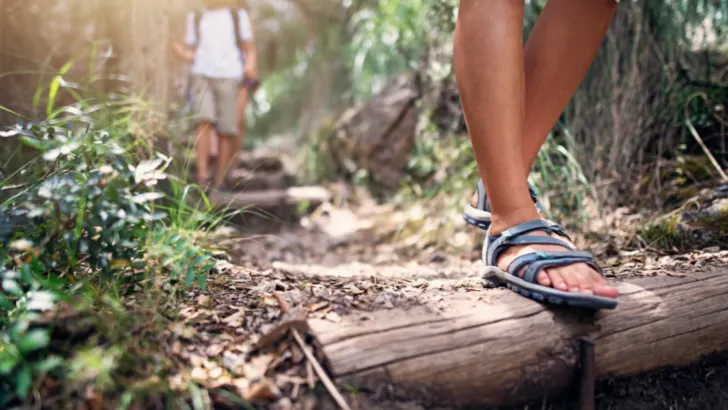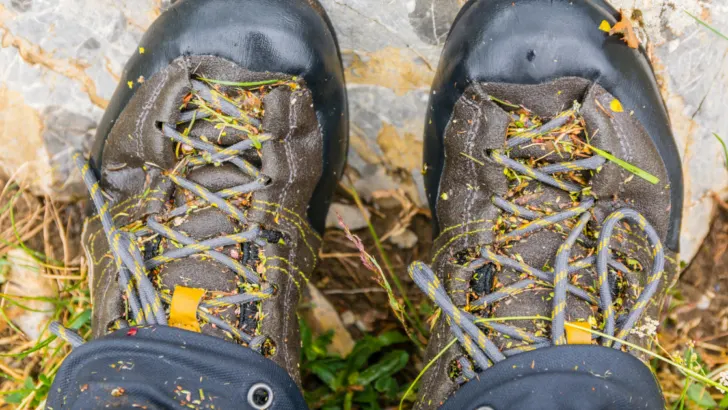Hiking in Crocs might seem like an odd choice at first, but it’s a topic that has been gaining popularity in recent years. Crocs are known for their comfort and versatility, and many hikers have started to wonder if these shoes could be a good option for their outdoor adventures.
While Crocs might not be the first choice for serious hikers tackling difficult terrain, they do have their advantages. For short hikes or walks in wet or muddy conditions, Crocs can be a great option. They’re lightweight, water-resistant, and easy to slip on and off, making them a convenient choice for many hikers.
However, there are also some downsides to hiking in Crocs. They don’t offer much ankle support or protection, and the soles can be quite thin, which can make it uncomfortable to walk on rocky or uneven terrain. Additionally, not all Crocs are created equal, and some models might not be suitable for hiking at all.

Key Takeaways
- Crocs can be a comfortable and convenient option for short hikes or walks in wet conditions.
- However, they don’t offer much ankle support or protection and might not be suitable for difficult terrain.
- It’s important to choose the right type of Crocs and wear them correctly to avoid any potential dangers.
Hiking in Crocs
As someone who enjoys hiking, I’ve often wondered if it’s possible to hike in Crocs. After doing some research and trying it out myself, I’ve come to the conclusion that it is possible, but with some limitations.
Crocs are lightweight, waterproof, and provide good traction on wet or muddy surfaces, making them a great option for short hikes or walks on easy terrain. They’re also comfortable and breathable, which is a plus for warm-weather hikes.
However, Crocs lack ankle support and a lacing system, which can make them unsuitable for longer hikes or hikes on difficult terrain. Without proper ankle support, your feet and ankles are more susceptible to injuries, especially on rocky or uneven terrain. Additionally, the lack of a lacing system means that your feet may slide around inside the shoe, causing blisters or discomfort.

If you do decide to hike in Crocs, there are a few things you can do to make the experience more comfortable and safe. Here are some tips:
- Wear thick socks to provide extra cushioning and support
- Use insoles to provide additional arch support
- Choose a route that is easy and well-maintained
- Bring a backup pair of shoes in case you need to switch out of your Crocs
In conclusion, hiking in Crocs is possible, but it’s important to be aware of the limitations and take precautions to prevent injuries and discomfort. If you’re planning a longer or more difficult hike, it’s probably best to opt for a more traditional hiking shoe with proper ankle support and a lacing system.
The Pros and Cons of Hiking in Crocs
Pros
As someone who has hiked in Crocs for years, I can attest to the fact that they do have some advantages. Here are some pros of hiking in Crocs:
- Comfortable: Crocs are known for their comfort, and this is no different when it comes to hiking. They have a cozy cushion and offer a barefoot walking quality that can be great for tired feet.
- Quick-drying: Crocs are made of a material that dries quickly, which is great for stream crossings or hiking in wet conditions.
- Low impact: Crocs are lightweight and have a low impact on the environment. They are also quiet, which can be an advantage when hiking in areas with wildlife.
- Easy to put on and take off: Crocs are slip-ons, which means they are easy to put on and take off. This can be convenient when hiking in areas where you need to take your shoes off frequently.
Cons
While there are some advantages to hiking in Crocs, there are also some downsides. Here are some cons of hiking in Crocs:
- Lack of support: Crocs are not designed for hiking, which means they do not provide the same level of support as hiking boots or shoes. This can be a disadvantage when hiking on uneven terrain or carrying a heavy backpack.
- Limited protection: Crocs do not provide much protection for your feet. They are open-toed and have a thin sole, which means your feet are more exposed to rocks, roots, and other hazards on the trail.
- Not suitable for all weather conditions: While Crocs are quick-drying, they are not suitable for all weather conditions. They are not warm enough for cold-weather hiking and can be slippery on wet or icy trails.
- Risk of blisters: Crocs can rub against your feet and cause blisters, especially if you are hiking long distances or in hot weather.
Overall, while hiking in Crocs can be comfortable and convenient, it is not always the best choice. It is important to consider the conditions of the trail and the needs of your feet before deciding to hike in Crocs.
Are Crocs Safe for Hiking?
As someone who loves hiking, I have always wondered if Crocs are safe for hiking. After doing some research and talking to other hikers, here’s what I found:
Pros of Hiking in Crocs
Crocs are lightweight, comfortable, and water-friendly, which makes them a popular choice for casual wear. When it comes to hiking, Crocs has some advantages:
- Breathability: Crocs allow air to circulate around your feet, which can help prevent blisters and keep your feet cool on hot days.
- Traction: Crocs have good traction on wet or muddy surfaces, which can be helpful when hiking near waterfalls or streams.
- Easy to clean: Crocs are easy to clean, which can be helpful when hiking in muddy or dusty conditions.

Cons of Hiking in Crocs
While Crocs have some benefits, they may not be the best option for all hiking conditions. Here are some reasons why:
- Lack of support: Crocs don’t provide much support for your feet, which can be a problem when hiking on uneven terrain or carrying a heavy backpack.
- Thin soles: Crocs have thin soles, which can make it easy to feel rocks, sticks, and other debris underfoot. This can be uncomfortable and even painful on longer hikes.
- Limited protection: Crocs don’t provide much protection from the elements or wildlife, which can be a problem when hiking in areas with rough terrain, snakes, or other hazards.
My Verdict
Based on my research and personal experience, I would say that Crocs can be safe for hiking in certain conditions. If you’re planning a short hike on flat, easy terrain or near water, Crocs can be a good choice. However, for longer hikes or more challenging terrain, I would recommend investing in a pair of hiking boots or shoes with more support and protection.
Other Footwear Options for Hiking
While Crocs may be a comfortable and lightweight option for hiking, they may not be the best choice for everyone or every type of hike. Here are some other footwear options to consider:
Hiking Boots
Hiking boots are a popular choice for many hikers and for good reason. They provide excellent support, protection, and traction, making them ideal for longer hikes and more challenging terrain. Look for boots with a sturdy sole, ankle support, and waterproofing if you plan on hiking in wet conditions.

Trail Running Shoes
Trail running shoes are a great option for those who want a lightweight and agile shoe for hiking. They offer good traction and breathability, and many models have a rock plate to protect your feet from sharp rocks and roots. However, they may not provide as much support as hiking boots, so they may not be the best choice for longer or more technical hikes.

Sandals
Sandals can be a comfortable and breathable option for hiking in warm weather or on less challenging trails. Look for sandals with a sturdy sole, good traction, and adjustable straps for a secure fit. However, they may not provide as much protection or support as other footwear options, so they may not be the best choice for longer or more technical hikes.

Approach Shoes
Approach shoes are designed for climbing and scrambling, but they can also be a good option for hiking on technical terrain. They offer good traction and protection, and many models have a sticky rubber sole for a better grip on rocks. However, they may not be as comfortable or breathable as other footwear options, so they may not be the best choice for longer hikes.

Ultimately, the best footwear for hiking depends on your personal preferences and the type of hike you plan on doing. Consider factors such as terrain, weather, and duration when choosing your footwear, and don’t be afraid to try different options until you find what works best for you.
Crocs Can Be Dangerous to Hike in If They Are Not Worn Correctly
As comfortable and versatile as Crocs are, they can also be dangerous to hike in if they are not worn correctly. Here are a few things to keep in mind to ensure a safe and enjoyable hiking experience in Crocs:
1. Choose the Right Crocs
Not all Crocs are created equal. When it comes to hiking, it’s important to choose a pair that is designed for outdoor activities. Look for Crocs with a thicker sole, better traction, and a secure fit. Avoid wearing classic clogs or flip-flops, as they are not suitable for hiking.
2. Mind the Terrain
Crocs are not the best option for rough or rocky terrain. They offer little protection and support, which can result in injuries. Avoid hiking in Crocs on trails with steep inclines, loose gravel, or sharp rocks. Stick to flat and easy trails if you must wear Crocs.
3. Watch Your Step
Crocs are slip-resistant, but they are not slip-proof. Be mindful of wet or slippery surfaces, as Crocs can lose their grip and cause you to slip or fall. Also, be careful when crossing streams or rivers, as the water can make the Crocs unstable and cause you to lose your balance.
4. Protect Your Feet
Crocs offer little protection against sharp objects or insects. Wear socks to prevent blisters and protect your feet from bites or stings. Consider packing a pair of lightweight hiking shoes or boots as a backup in case you need more protection.
5. Don’t Overdo It
Crocs are great for short hikes or as a backup option, but they are not meant for long-distance hiking or strenuous activities. Avoid overdoing it in Crocs, as they can cause fatigue, cramps, or other injuries. If you plan on hiking for more than a few hours or on a challenging trail, wear proper hiking shoes or boots.
By following these tips, you can safely hike in Crocs and enjoy all the benefits they have to offer. However, if you’re not comfortable or confident in hiking in Crocs, it’s always better to err on the side of caution and wear proper hiking shoes or boots.
Different Types of Crocs That Exist, and Which Ones Are Best Suited for Hiking
As per my research, there are several types of Crocs available in the market, each with its unique features and benefits. Here are some of the most popular types of Crocs and their suitability for hiking:
Classic Clogs
The Classic Clogs are the iconic Crocs that come to mind when you think of the brand. They are comfortable, lightweight, and easy to slip on and off. However, they may not be the best option for hiking, as they lack the necessary support and traction for rough terrains.
All-Terrain Clogs
All-Terrain Clogs are designed for outdoor activities and offer better traction and support than Classic Clogs. They feature a thicker and more rugged sole that provides better grip on uneven surfaces. These Crocs are a good option for light hiking on easy-to-moderate terrains.
Hiker Clogs
Hiker Clogs are specifically designed for hiking and other outdoor activities. They offer superior traction, support, and comfort, making them an excellent choice for longer hikes and more challenging terrains. They feature a thicker and more durable sole, a secure fit, and a closed-toe design that protects your toes from rocks and other debris.
LiteRide 360 Clogs
LiteRide 360 Clogs are a newer addition to the Crocs line and feature a lightweight and flexible foam sole that provides excellent cushioning and support. They are suitable for light hiking on easy-to-moderate terrains and are a good option for those who prefer a more cushioned and comfortable shoe.
In summary, for hiking purposes, the All-Terrain, Hiker, and LiteRide 360 Clogs are the best options. They offer better traction, support, and protection than the Classic Clogs and are designed specifically for outdoor activities. However, it’s important to keep in mind that Crocs are not a substitute for proper hiking shoes and should only be used for light hiking on easy to moderate terrains.
Conclusion
In conclusion, hiking in Crocs can be a viable option for certain types of hikes and activities. Crocs are lightweight, comfortable, and water-friendly, making them perfect for short hikes on well-maintained trails or water-based activities. They also provide good traction on wet or muddy surfaces.
However, it’s important to consider the limitations and safety considerations they present. Crocs lack ankle support and a lacing system, which can be problematic for longer hikes or when carrying a heavy backpack on steep inclines. Therefore, it’s recommended to opt for sturdier hiking boots for more challenging terrains or longer hikes.

Additionally, it’s important to note that personal comfort and preference play a significant role in the decision to wear Crocs for hiking. Some hikers may find them too casual or not protective enough, while others may appreciate the unique and unconventional footwear for their adventures.
Ultimately, the decision to wear Crocs for hiking should be based on the individual’s personal needs and preferences, as well as the specific requirements of the hike or activity.
Resources: https://www.crocs.com/c/shop-by/activity/outdoor-shoes
Frequently Asked Questions
What are the best hiking shoes for long distances?
When it comes to hiking long distances, it is important to have shoes that provide good support and comfort. While Crocs are comfortable and lightweight, they may not be the best option for long hikes. It is recommended to invest in hiking shoes or boots that have good ankle support, a sturdy sole, and are waterproof.
Are men’s hiking Crocs a good option for hiking?
Men’s hiking Crocs can be a good option for hiking, but it depends on the type of hike and the terrain. Crocs are lightweight and breathable, which makes them great for short hikes on flat or easy terrain. However, for longer hikes or more challenging terrain, it is recommended to wear shoes with better support and traction.
Are women’s hiking Crocs a good option for hiking?
Women’s hiking Crocs can be a good option for hiking, but it depends on the type of hike and the terrain. Crocs are lightweight and breathable, which makes them great for short hikes on flat or easy terrain. However, for longer hikes or more challenging terrain, it is recommended to wear shoes with better support and traction.
Can Crocs be used for hiking long distances?
While Crocs can be used for hiking long distances, they may not be the best option. Crocs lack the ankle support and sturdy sole that hiking shoes or boots provide, which can lead to discomfort and injury on longer hikes. It is recommended to wear shoes that are specifically designed for hiking long distances.
Are Crocs suitable for hiking in rough terrain?
Crocs may not be the best option for hiking in rough terrain. The lack of ankle support and sturdy sole can make it difficult to navigate through rocky or uneven terrain. It is recommended to wear shoes or boots that provide good support and traction for hiking in rough terrain.
Do Crocs make hiking boots for outdoor activities?
Crocs does make hiking boots for outdoor activities. These boots are designed to provide good support and traction for hiking on various types of terrain. However, it is important to do research and read reviews before purchasing any hiking boots, including those made by Crocs, to ensure they are suitable for your specific needs.
